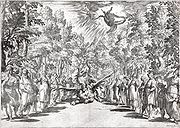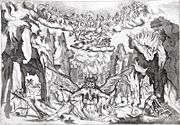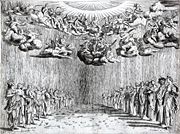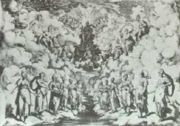
Intermedio
Encyclopedia


- For the film, see Intermedio (film)Intermedio (film)Intermedio is an American horror film released in March 2005.-Cast:-Synopsis:In a small California town, Malik along with his former girlfriend Gen her friend Barbie , and another friend named Wes take a weekend getaway to an old ghost town where Malik and Gen played when they were younger.The...
.
The intermedio, or intermezzo, in the Italian Renaissance
Italian Renaissance
The Italian Renaissance began the opening phase of the Renaissance, a period of great cultural change and achievement in Europe that spanned the period from the end of the 13th century to about 1600, marking the transition between Medieval and Early Modern Europe...
, was a theatrical performance or spectacle with music
Renaissance music
Renaissance music is European music written during the Renaissance. Defining the beginning of the musical era is difficult, given that its defining characteristics were adopted only gradually; musicologists have placed its beginnings from as early as 1300 to as late as the 1470s.Literally meaning...
and often dance which was performed between the acts of a play to celebrate special occasions in Italian courts
Noble court
The court of a monarch, or at some periods an important nobleman, is a term for the extended household and all those who regularly attended on the ruler or central figure...
. It was one of the important predecessors to opera
Opera
Opera is an art form in which singers and musicians perform a dramatic work combining text and musical score, usually in a theatrical setting. Opera incorporates many of the elements of spoken theatre, such as acting, scenery, and costumes and sometimes includes dance...
, and an influence on other forms like the English court masque
Masque
The masque was a form of festive courtly entertainment which flourished in 16th and early 17th century Europe, though it was developed earlier in Italy, in forms including the intermedio...
. Weddings in ruling families and similar state occasions were the usual occasion for the most lavish intermedi, in cities such as Florence
Florence
Florence is the capital city of the Italian region of Tuscany and of the province of Florence. It is the most populous city in Tuscany, with approximately 370,000 inhabitants, expanding to over 1.5 million in the metropolitan area....
and Ferrara
Ferrara
Ferrara is a city and comune in Emilia-Romagna, northern Italy, capital city of the Province of Ferrara. It is situated 50 km north-northeast of Bologna, on the Po di Volano, a branch channel of the main stream of the Po River, located 5 km north...
. Some of the best documentation of intermedi comes from weddings in the Medici
Medici
The House of Medici or Famiglia de' Medici was a political dynasty, banking family and later royal house that first began to gather prominence under Cosimo de' Medici in the Republic of Florence during the late 14th century. The family originated in the Mugello region of the Tuscan countryside,...
family, in particular the 1589 Medici wedding, which featured what was undoubtedly both the most spectacular set of intermedi, and the best known, thanks to no fewer than 18 contemporary published festival books and sets of prints
Old master print
An old master print is a work of art produced by a printing process within the Western tradition . A date of about 1830 is usually taken as marking the end of the period whose prints are covered by this term. The main techniques concerned are woodcut, engraving and etching, although there are...
that were financed by the Grand Duke.
Intermedi were written and performed from the late 15th century through the 17th century, although the peak of development of the genre was in the late 16th century. After 1600 the form merged with opera, for the most part, though intermedi continued to be used in non-musical plays in certain settings (for example in academies), and also continued to be performed between the acts of operas.
Development
The first intermedii were not in Florence but in FerraraFerrara
Ferrara is a city and comune in Emilia-Romagna, northern Italy, capital city of the Province of Ferrara. It is situated 50 km north-northeast of Bologna, on the Po di Volano, a branch channel of the main stream of the Po River, located 5 km north...
at the end of the 15th century between the five acts of plays by the classical authors Plautus
Plautus
Titus Maccius Plautus , commonly known as "Plautus", was a Roman playwright of the Old Latin period. His comedies are the earliest surviving intact works in Latin literature. He wrote Palliata comoedia, the genre devised by the innovator of Latin literature, Livius Andronicus...
and Terence
Terence
Publius Terentius Afer , better known in English as Terence, was a playwright of the Roman Republic, of North African descent. His comedies were performed for the first time around 170–160 BC. Terentius Lucanus, a Roman senator, brought Terence to Rome as a slave, educated him and later on,...
. Writing of the "intermezzi" at the wedding of Lucrezia Borgia
Lucrezia Borgia
Lucrezia Borgia [luˈkrɛtsia ˈbɔrʤa] was the illegitimate daughter of Rodrigo Borgia, the powerful Renaissance Valencian who later became Pope Alexander VI, and Vannozza dei Cattanei. Her brothers included Cesare Borgia, Giovanni Borgia, and Gioffre Borgia...
in 1502, Isabella d'Este
Isabella d'Este
Isabella d'Este was Marchesa of Mantua and one of the leading women of the Italian Renaissance as a major cultural and political figure. She was a patron of the arts as well as a leader of fashion, whose innovative style of dressing was copied by women throughout Italy and at the French court...
said that they were more interesting than the boring commedia, "a remark destined to be often repeated". Ferrara intermezzi at this period were short and without a unifying theme; they included choruses, recitations and moresca
Moresca
Moresca or Mauresque is a 15th/16th century pantomime dance in which the executants wore Moorish costumes. One such is the concluding music of Monteverdi's L'Orfeo...
dances. But by 1513 there was a unifying allegory
Allegory
Allegory is a demonstrative form of representation explaining meaning other than the words that are spoken. Allegory communicates its message by means of symbolic figures, actions or symbolic representation...
, explained at the end. It was for Florentine public celebrations that Intermedii came into their own; several were organised by Machiavelli when he was part of the government of the Republic of Florence
Republic of Florence
The Republic of Florence , or the Florentine Republic, was a city-state that was centered on the city of Florence, located in modern Tuscany, Italy. The republic was founded in 1115, when the Florentine people rebelled against the Margraviate of Tuscany upon Margravine Matilda's death. The...
in the early 16th century, and the returning Medici adopted a policy of keeping the aristocracy occupied by involving them in productions.
As the intermedio developed in the 16th century, it grew more and more elaborate, often becoming a "play within a play"; for example during a five-act play, an intermedio would consist of four parts, which might be presented as a four-part metaphor of time passing in the play. This stage begins with Il commodo, from the Medici wedding in Florence
Florence
Florence is the capital city of the Italian region of Tuscany and of the province of Florence. It is the most populous city in Tuscany, with approximately 370,000 inhabitants, expanding to over 1.5 million in the metropolitan area....
of Cosimo I
Cosimo I de' Medici, Grand Duke of Tuscany
Cosimo I de' Medici was Duke of Florence from 1537 to 1574, reigning as the first Grand Duke of Tuscany from 1569.-Biography:...
and Eleanor of Toledo in 1539, where the four parts were morning, noon, afternoon, and night, represented with an elaborate mechanical artificial sun, with singing and dancing appropriate to each time. Some critics of the time noted that the intermedi had become so elaborate that the play had begun to serve as intermedi to the intermedi.
Mature intermedio
Originally intermedi had used the sets already on the stage from the main play, typically fairly simple ones for a comedy, with a few extra pieces, but later they had their own sets, which a mythological subject required to be more elaborate. Vasari's production for yet another Medici wedding in 1565 "embodied stupendous advances in engineering technique" with all the elaborate movements of scenery done without a curtain in full view of the audience. According to Roy StrongRoy Strong
Sir Roy Colin Strong FRSL is an English art historian, museum curator, writer, broadcaster and landscape designer. He has been director of both the National Portrait Gallery and the Victoria and Albert Museum in London...
: "the designs for the 1589 intermezzi are crucial, for they are the earliest mass-disseminated illustrations of what became a norm throughout Europe for theatrical visual experience for the next three hundred years, the proscenium arch behind which receded ranks of side wings, the vista closed by a back-shutter." Eventually the form acquired a tradition and cohesiveness that allowed it to stand on its own, and it was thus a logical development to combine the existing features with sung, acted parts, and be absorbed into the new artform of opera, which also drew from the traditions of monody
Monody
In poetry, the term monody has become specialized to refer to a poem in which one person laments another's death....
and madrigal comedy
Madrigal comedy
Madrigal comedy is a term for a kind of entertainment music of the late 16th century in Italy, in which groups of related, generally a cappella madrigals were sung consecutively, generally telling a story, and sometimes having a loose dramatic plot. It is an important element in the origins of opera...
. Jacopo Peri
Jacopo Peri
Jacopo Peri was an Italian composer and singer of the transitional period between the Renaissance and Baroque styles, and is often called the inventor of opera...
, the composer of Dafne
Dafne
Dafne is the earliest known work that, by modern standards, could be considered an opera. It was composed by Jacopo Peri in 1597, with a libretto by Ottavio Rinuccini.-History:...
, the first opera, was one of the composers, and almost certainly performers, in the 1589 Medici intermezzi, and the librettist for both, Ottavio Rinuccini
Ottavio Rinuccini
Ottavio Rinuccini was an Italian poet, courtier, and opera librettist at the end of the Renaissance and beginning of the Baroque eras...
, seems to have recycled in Dafne some of the material from the 1589 Delos scene (illustrated at top).

Madrigal (music)
A madrigal is a secular vocal music composition, usually a partsong, of the Renaissance and early Baroque eras. Traditionally, polyphonic madrigals are unaccompanied; the number of voices varies from two to eight, and most frequently from three to six....
s and instrumental pieces, was often used in intermedi. The subject matter of the intermedio was usually a mythological
Mythology
The term mythology can refer either to the study of myths, or to a body or collection of myths. As examples, comparative mythology is the study of connections between myths from different cultures, whereas Greek mythology is the body of myths from ancient Greece...
or pastoral
Pastoral
The adjective pastoral refers to the lifestyle of pastoralists, such as shepherds herding livestock around open areas of land according to seasons and the changing availability of water and pasturage. It also refers to a genre in literature, art or music that depicts such shepherd life in an...
story, which could be told in mime
Mime artist
A mime artist is someone who uses mime as a theatrical medium or as a performance art, involving miming, or the acting out a story through body motions, without use of speech. In earlier times, in English, such a performer was referred to as a mummer...
, by costumed singers or actors, or by dance
Dance
Dance is an art form that generally refers to movement of the body, usually rhythmic and to music, used as a form of expression, social interaction or presented in a spiritual or performance setting....
, or any combination of these. There was invariably a political message, even if this was limited to general glorification of the ruling family; at times more specific messages were intended. Some thematic connection with the main play might be made, though intermedii could be repeated with different plays from the one they were written for.
Numerous drawings and engravings of the stage sets survive, as well as texts of the libretti and descriptions of the music and action; the 1589 Medici intermezzi were especially well recorded, and "were to be the fount of Italian baroque
Baroque
The Baroque is a period and the style that used exaggerated motion and clear, easily interpreted detail to produce drama, tension, exuberance, and grandeur in sculpture, painting, literature, dance, and music...
scenography as well as influencing the development of the stage north of the Alps, above all the Stuart court masque
Masque
The masque was a form of festive courtly entertainment which flourished in 16th and early 17th century Europe, though it was developed earlier in Italy, in forms including the intermedio...
s designed by Inigo Jones
Inigo Jones
Inigo Jones is the first significant British architect of the modern period, and the first to bring Italianate Renaissance architecture to England...
". The actual content in terms of staging, music, instrumentation, presence of singers, actors, dancers, or mime was highly variable throughout the period, and sometimes all of these features were present. The 1589 intermedi were performed in the recently completed theatre in the Uffizi Palace before an audience of about three thousand, and three further performances were given some days after the end of the wedding festivities.
Further significant sets of Medici intermedi were produced for the weddings in 1600 of Henry IV of France
Henry IV of France
Henry IV , Henri-Quatre, was King of France from 1589 to 1610 and King of Navarre from 1572 to 1610. He was the first monarch of the Bourbon branch of the Capetian dynasty in France....
and Marie de' Medici
Marie de' Medici
Marie de Médicis , Italian Maria de' Medici, was queen consort of France, as the second wife of King Henry IV of France, of the House of Bourbon. She herself was a member of the wealthy and powerful House of Medici...
, and then in 1608 of Grand Duke Cosimo II
Cosimo II de' Medici, Grand Duke of Tuscany
Cosimo II de' Medici was Grand Duke of Tuscany from 1609 until 1621. He was the elder son of the then incumbent Grand Duke and Christina of Lorraine. He married Maria Magdalena of Austria, and had eight children....
and a Habsburg
Habsburg
The House of Habsburg , also found as Hapsburg, and also known as House of Austria is one of the most important royal houses of Europe and is best known for being an origin of all of the formally elected Holy Roman Emperors between 1438 and 1740, as well as rulers of the Austrian Empire and...
princess, Maria Magdalena of Austria. However the 1600 celebrations also included a portent of things to come in the form of performances of Jacopo Peri
Jacopo Peri
Jacopo Peri was an Italian composer and singer of the transitional period between the Renaissance and Baroque styles, and is often called the inventor of opera...
's opera Euridice
Euridice (opera)
Euridice is an opera by Jacopo Peri, with additional music by Giulio Caccini. The libretto by Ottavio Rinuccini is based on books X and XI of Ovid's...
, the earliest surviving example of the form.
Music of the Medici intermedi

Cristofano Malvezzi
Cristofano Malvezzi was an Italian organist and composer of the late Renaissance. He was one of the most famous composers in the city of Florence during a time of transition to the Baroque style....
, an almost complete version of La Pellegrina (1589) are known to have survived.
In 1539 most of the pieces are in four and five parts so much of this music is suitable for domestic playing. The 1589 music is very different being largely big set pieces for 6, 12, 18 or even 30 parts; 41 instrumentalists were required in all, some hidden around the stage as there was not room for them all in one place. Smaller scale pieces are often difficult florid monody
Monody
In poetry, the term monody has become specialized to refer to a poem in which one person laments another's death....
of the Caccini
Caccini
Caccini is the name of several composers and artists from Florence:* Giulio Caccini , Florentine composer, significant innovator of the early Baroque era...
new music variety.
Of the surviving intermedii only two numbers were a cappella
A cappella
A cappella music is specifically solo or group singing without instrumental sound, or a piece intended to be performed in this way. It is the opposite of cantata, which is accompanied singing. A cappella was originally intended to differentiate between Renaissance polyphony and Baroque concertato...
, (not counting the madrigal
Madrigal (music)
A madrigal is a secular vocal music composition, usually a partsong, of the Renaissance and early Baroque eras. Traditionally, polyphonic madrigals are unaccompanied; the number of voices varies from two to eight, and most frequently from three to six....
s which were sung at the banquet in 1539 which of course are not intermedii). This means we have surviving descriptions of precise instrumentation.
Classical humanist dramatic theory says a play should have action taking place during one entire day. These intermedii do not follow what were believed to be the classical instructions, having an overture item, Vattene almo riposo, and a night time ending for tenor voice accompanied by four sackbut
Sackbut
The sackbut is a trombone from the Renaissance and Baroque eras, i.e., a musical instrument in the brass family similar to the trumpet except characterised by a telescopic slide with which the player varies the length of the tube to change pitches, thus allowing them to obtain chromaticism, as...
s and an extra coda
Coda (music)
Coda is a term used in music in a number of different senses, primarily to designate a passage that brings a piece to an end. Technically, it is an expanded cadence...
the bacchanale
Bacchanale
A bacchanale is a dramatic musical composition, often depicting a drunken revel or bacchanal.Well-known examples are the bacchanales in Camille Saint-Saëns's Samson et Dalila and the Overture and Bacchanale of Richard Wagner's Tannhäuser. John Cage wrote a Bacchanale for prepared piano...
, Baccho, Baccho, E U O E.
Similar forms outside Italy
The similar form which developed in France at the same time was called the intermèdeIntermède
Intermède is a French term for a musical or theatrical performance involving song and dance, also an 18th-century opera genre.The context in which the 'intermède' was performed has changed over time. During the 16th century they were court entertainments in which ballet was an important element...
; it was more reliant on dance than the Italian version. The French court under Catherine de' Medici
Catherine de' Medici
Catherine de' Medici was an Italian noblewoman who was Queen consort of France from 1547 until 1559, as the wife of King Henry II of France....
was also staging court festivities of increasing lavishness
Catherine de' Medici's court festivals
Catherine de' Medici's court festivals were a series of lavish and spectacular entertainments, sometimes called "magnificences", laid on by Catherine de' Medici, the queen consort of France from 1547 to 1559 and queen mother from 1559 until her death in 1589...
– Catherine's granddaughter was the Medici bride in 1589. The masque
Masque
The masque was a form of festive courtly entertainment which flourished in 16th and early 17th century Europe, though it was developed earlier in Italy, in forms including the intermedio...
in England also had many similarities to the intermedio, although it did not originate as a "filler" between acts in a play in the same way. The later 18th century intermezzo
Intermezzo
In music, an intermezzo , in the most general sense, is a composition which fits between other musical or dramatic entities, such as acts of a play or movements of a larger musical work...
in opera showed a reversal of the Renaissance scheme; now a single short comic intermezzo was inserted between the acts of a heroic opera seria
Opera seria
Opera seria is an Italian musical term which refers to the noble and "serious" style of Italian opera that predominated in Europe from the 1710s to c. 1770...
.
Editions of the music
- Andrew C. Minor and Bonner Mitchell, A Renaissance Entertainment, (Univ. Missouri Press, 1968).
- Martin Grayson, George and Rosemary Bate, Music for a Medici Wedding, (Modern playing edition of 1539 Intermedio), http://www.alfredston-music.co.uk (1994).
- D. P. Walker, Musique des Intermedes de "La Pellegrina", (CNRS, Paris), (1963, reprinted 1986).
Discography
- Firenze 1539 - Musiche fatte nelle nozze dello illustrissimo duca di Firenze il signor Cosimo de Medici et della illustrissima consorte sua mad. Leonora da Tolletto, Centro de Musique Ancienne di Genevra / Studio di Musica Rinascimentale di Palermo / Schola "Jacopo da Bologna", conducted by Gabriel Garrido, (TACTUS TC 500301).
- Ein Hochzeitsfest in Florenz 1539, Weser-Renaissance Bremen, conducted by Manfred Cordes, in: Tage alter Musik in Herne 2001: Allianzen - Musik und Politik in Werken vom Mittelalter bis zur Romantik. Westdeutscher Rundfunk Köln / Tage alter Musik Herne, http://www.tage-alter-musik.de (2001). Only the intermedii by Corteccia.
- La Pellegrina - Music for the Wedding of Ferdinando De Medici and Christine de Lorraine, Florence 1589, conducted by Andrew Parrot, (EMI).
- La Pellegrina - Music for the Wedding of Ferdinando De Medici and Christine de Lorraine, Princess of France, Florence 1589, conducted by Paul Van NevelPaul Van NevelPaul Van Nevel is a Belgian conductor, musicologist and art historian. In 1971 he founded the Huelgas Ensemble, a choir dedicated to polyphony from the Middle Ages and the Renaissance. Van Nevel is known for hunting out little known polyphonic medieval works to perform.He grew up in a musical...
, singers: Katelijne Van Laethem, Pascal Bertin, et al. (Sony/Columbia - 63362, 1998). 2 CDs. - La Pellegrina - Intermedii 1589, Capriccio Stravagante Renaissance Orchestra and Collegium Vocale Gent conducted by Skip Sempe, singers: Dorothée Leclair, Soprano / Monika Mauch, Soprano / Pascal Bertin, Alto / Stephan van Dyck, Tenor / Jean-François Novelli, Tenor / Antoni Fajardo, Bass. (2 CDs Paradizo PA0004 - 2007)

